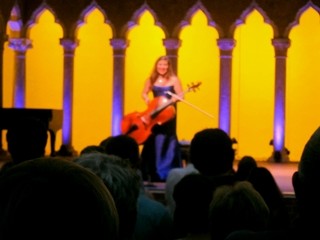|
Back
Nights in the Gardens of Caramoor New York
VenetianTheater, Caramoor Center for Music and the Arts
07/31/2014 -
Benjamin Britten: Tema Sacher
Osvaldo Golijov: Omaramor
Johann Sebastian Bach: Cello Suite No. 3 in C, BWV 1009
Zoltán Kodály: Sonata for Solo Cello, Opus 8
Alisa Weilerstein (Cellist)

A. Weilerstein?? (© Pablo Picasso)
One can’t help but think of Pablo Picasso’s fascinating painting of a female cellist when listening to Alisa Weilerstein. With each unusual selection she has played recently in New York–Matthew Pintscher’s Reflections on Narcissus, Penderecki’s Concerto grosso, or the more familiar Tchaikovsky Rococo Variations–she becomes the painting.
Yes, the multiple voices and phases, the grace of both body and instrument together. But most of all, Picasso (a cellist himself) put a Valentine’s Day heart right in the middle of the painting. And while every serious cello soloist puts heart and soul into the playing, Ms. Weilerstein wears her heart on her fingers. The warmth is evident, but the passion bursts out from each note, and each chord over the four strings.
That she is Caramoor artist-in-residence this weekend hardly begins to describe her association with these spacious gardens north of Westchester County. As Ms. Weilerstein noted in her charming introduction to the sellout crowd yesterday, she not only made many appearances here more than a decade ago, but Caramoor was the site for her marriage last year.
Nor could any place be more romantic. Just five miles from the charming town of Katonah, the gardens and pavilions and tented theaters play host every summer to some excellent musicians. An early audience can amble through the gardens, finding surprises (like a Dali-esque piano sculpture) and then the solace of the music.

A. Weilerstein at Caramoor (© Coco T. Dog)
Ms. Weilerstein was scheduled to play her solo recital yesterday al fresco in the Spanish Gardens. But with clouds looming over the gardens, the Caramoor Powers changed that to the large tent-covered “Venetian Theater”. It didn’t rain, the tent didn’t hide a plane which overcame part of the Kodály Sonata, but Ms. Weilerstein obviously felt at home here.
Tonight she does chamber music, and later an orchestral concert with St. Luke’s, but yesterday she played four solo works. Though such is her touch, and such the multiple colors of her instrument, one never quite believed that she was alone on this large stage.
The early evening began with Benjamin Britten’s pièce d’occasion, dedicated and with a coded reference for Paul Sacher, the Swiss benefactor and conductor who had brought forth some of the 20th Century’s greatest pieces of music, including Britten’s own Cantata Academica. Lasting a bit more than a minute, this was a complex little equation–but Ms. Weilerstein played it with all the passion she could give to a Dvorák Concerto.
The next work was hardly enigmatic, for Osvaldo Golijov is one of those composers who, no matter how complex the composition, always leaves room for something familiar, some bits of melody or modal reference which puts us on firm ground. Besides this, Ms. Weilerstein has had a long professional relationship with Mr. Golijov, and for good reason. She plays his music with the most stunning clarity, making those codes and references come alive.
For Omaramor, Golijov went back to his birth-roots, in Argentina, where the great Carlos Gardel–a man whose tragic end in an airplane crash makes his iconic stature even greater–had written one lasting work on his home town.
But this piece wasn’t the song about Buenos Aries. It was the playful mood around the song. With a wealth of cello chords, Ms. Weilerstein plunged through street noises, rough harmonies, bits of the original tango, back to the streets, and–as if coming from an itinerant singer in a remote alley–the song appeared again. In whispers, shouted out and back again to a low voice.
I have heard this played with sharp tango rhythms, but Ms. Weilerstein worked it the way Debussy worked his Iberian rhythms, subtle, shadowy, even more welcome when they appeared. It was a gorgeous mélange of the familiar and the mysterious.
The two long works over this hour’s recital were Bach and Kodály. And the Third Bach Suite could be the landmark for any great cellist. Yo-Yo Ma plays it with the most poetic sensibility. Casals, the first to play it in the 20th Century, gave such an austere performance that one can hardly listen today. Rostropovich understood its exuberance.
And Ms. Weilerstein came close to the Russian in understanding just how exuberant were these dances.
Reading now John Eliot Gardiner’s magisterial tome on Bach, I find he has little time for the instrumental works. (He’s a vocal guy.) But his dogma, that one must understand the dancing rhythms of Bach to understand the composer, certainly is true in the suites. Mr. Weilerstein had an equal understanding, and she showed off her work with a full-bodied feeling for the Prelude, the fast-moving Bourrées (which she had played in New York as an encore) and the courante. But her triumph was in the final Gigue.
Picasso appears at the head of this review, but Ms. Weilerstein turned this into dance which Bruegel could have painted. Bach was a city/town boy, and we confine our pictures of him to the organ loft. But the peasant countryside was always in the “suburbs” and he would have probably enjoyed the bumptious festivals. Thus, Ms. Weilerstein’s accentuation on the bagpipe-like drone, and the duets above this drone on the lowest string had a full-bodied vernal peasant ring.
The same droning ring which Zoltán Kodály gave in his gigantic Solo Cello Sonata, the final work on the program. Here again, Ms. Weilerstein understood this not as a challenge to the cellist–which it most certainly is–but as a paean to Magyar music itself.
Its technical difficulties come not from the retuning of the cello (to make the B minor home key) or the quadruple-string playing (three bottom strings against the soaring figure on top), but the fact that Hungarian music is a lot like the Magyar language. Nothing is as it sounds. The accents, the grace notes in the “wrong” place, the changes of rhythm and key, the ornaments, are all “exotic”. Added to this Kodály has added instrumental effects far from the cello. In the final movement we had a zither-like cimbalom, a guitar, trills and tremolos which I used to hear from the simplified oboes and clarinets of Hungary far outside Budapest.
She was, in fact, a one-girl Hungarian band, leaving us poor souls in the audience exhausted, while she remained oh so cool.
Reading the score before going to Caramoor, the Zoltán Sonata looked like the most daring difficult piece for listening. Ms. Weilerstein made it sound as natural–and as alien–as Hungary itself.
The sun had barely gone down on Caramoor when this 6pm performance was finished, but one didn’t need more sauntering nature. Alisa Weilerstein had once again showed such an original artistry that the flowers and ponds great lawns seemed almost like adjuncts to her own so natural abilities and extraordinary art.
Harry Rolnick
|